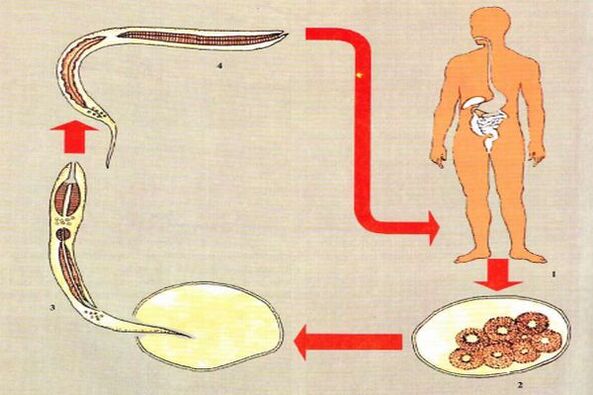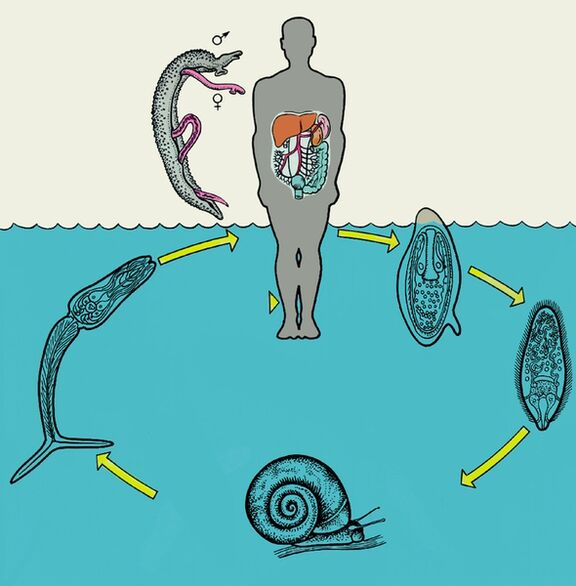Life cycle- these are all developmental stages "from egg to egg", and in the absence of an egg, from any stage to the closest similar one. The main biological aspects of the life of any organism are adaptations that ensure the preservation of the individual and the species.
In the case of parasites (in contrast to free-living animals), nutrition is provided without interruption, therefore the reproductive activity of the organism increases. Due to the spatial and temporal limitations of the parasite's habitat, the increased reproduction of the parasite leads to the rapid overpopulation of this place and, in this connection, the need for its relocation to preserve the species.
The totality of all stages of the parasite's ontogenesis and its transmission routes from one host to another is called its life cycle.
Forms of cycles
Having discovered that parasites are organisms that use other organisms for their development, it is important to understand what possibilities exist for the development of life. According to the classification, there are simple and complex cycles. The first takes place without a change of ownership. Examples: roundworm, amoeba, whipworm, etc. A complex group includes several owners at the same time. These can be vertebrates, fish, shellfish, etc. For example, helminths.
The development cycle of whipworms does not require an intermediate host.
After entering the definitive host, the parasites grow and multiply. Depending on the type of pathogen, the larvae may remain inside or leave the body. In most cases, excretion occurs through the intestines. This makes it possible to determine the type of pathogen with simple tests.
Characteristics of cyclic sections
Each stage of development has its own characteristics. Only this factor determines the treatment. This can be explained by the fact that, for example, not all drugs have an effect on larvae, while it is much easier to get rid of mature parasites.
The intermediate and final carrier of the parasite depends on the type of helminthiasis.
In this regard, let's see how the development cycle is progressing:
- Distribution - this cycle occurs when the intermediate host, which is the source but not the final stage, is currently the only option, i. e. there is no potential final host. In such a situation, the intermediate host is used for further development and nutrition.
- Active growth - after reaching the most suitable conditions, the parasite stops, repairs itself if suitable means are provided, and begins to grow into a sexually mature state.
- Migration to another habitat - after an adult individual reproduces the eggs, in most cases they migrate for further development. They can be distributed in different ways. Most often, parasites migrate through the digestive tract with the bulk of food. There are also those that, due to their size, easily enter the bloodstream and spread throughout the body.
- Asexual reproduction - some types of parasites are distinguished by the fact that they do not need a second partner to reproduce. The most striking example is the tapeworm, in which each strobila has a bee that reproduces the mature eggs.

Important concepts
The first thing to highlight when learning about parasites is the concept of the "host". This is an organism in which parasites develop and multiply. The "intermediate host" stands out. In this case, the pathogen remains in the body until it has the opportunity to migrate to the most favorable environment provided by the final host.
The cycle can occur with 1-4 host changes. In this case, the first is intermediate and the others are supplementary. Parasites enter the final host through direct contact or through an intermediate host. This is where development and sexual reproduction take place.
The development of the parasite begins when it enters the definitive host.
There are also concepts such as reservoir parasitism and host-feeder. In the first case, we are talking about a situation where the parasite can remain unchanged for a long time after reaching the right conditions, waiting for a more favorable settlement opportunity.
Service provider owneran organism used exclusively as food. The simplest option is pliers. If we look at how these types of parasites feed, we can understand that they need human blood to exist, but they do not stay in or on the human body for a long time.
A distinction is also made between the concepts of "parasite reservoir" and "reservoir host". This is a host in whose body the pathogen can live for a long time, accumulate, multiply and spread in the surrounding area.
Biology of parasites
The carriage of the parasite must be taken into account separately - in the case of pathogenic parasites living in the human body, but the development of the disease does not occur. However, such a person is a danger to others.
The parasite and its host influence each other.
The harmful effects of the parasite on the host:
- Mechanical;
- Toxic;
- Food deprivation;
- Violation of tissue integrity.
Accordingly, the host "responds" to the influence of the parasite.
Infections caused by parasites can be divided according to the sensitivity of the pathogen to the host:
- Anthroponotic - man behaves as a farmer;
- Zoonosis - various animals act as hosts;
- Anthropozoonotic diseases are invasive and infectious diseases that are common in humans and animals.
Medical parasitology consists of three main parts:
- Protozoan parasites - protozoology.
- Parasitic worms, worms - helminthology.
- Arthropods - arachnology.

Life cycle stages
In most cases, protozoans have special stages that are suitable for carrying out the transition phase from one host to another. These stages are called propagative.
In intestinal parasitesreproductive stagesthey usually adapt to the experiences of the external environment. Most intestinal protozoa form cysts covered by a dense membrane. When the cysts of several species (Entamoeba histolytica, E. coli, Lamblia intestinalis, etc. ) mature, several consecutive divisions of the cell nucleus occur.
After hitting a maturemultinucleated cystIn the new host, the cytoplasm divides and several individuals are formed. Cysts are usually provided with nutritional supplements, which are consumed during the maturation process and when the cyst remains in the external environment. The reproductive stage of coccidia is a membrane-encased, fertilized female germ cell (oocyst).
Most parasites are protozoansthe tissues and blood of vertebrates are transmitted from one host to another by means of a vector. In this case, the reproductive stages are localized in the blood or in the external body of the vertebrate. The causative agent of Chagas' disease, Trypanosoma cruzi, reproduces in the cells of the internal organs during the leishmanial phase. The leishmanial forms of the parasite transform into trypanosomes, which enter the bloodstream but do not reproduce in it.
Transmission of infectionit is carried out through a vector, a blood-sucking bug. The causative agent of Indian visceral leishmaniasis (kala-azar), Leishmama donovani, multiplies in the histophagocytic cells of tissues that are poorly accessible to the vector. However, in the late stages of the process, late leishmanoid - lesions containing a large number of leishmania - may develop on the patient's skin. In some cases, with this disease, leishmania can also be found in the blood. The reproductive stages of malaria parasites are gamonts, which circulate in the host's bloodstream.
Togetherreproductive stagesin the life cycle of tissue parasites are so-calledinvasive stagescapable of penetrating a vertebrate host. Thus, the development of representatives of the genus Trypanosoma in the vector ends with the formation of metacyclic trypanosomes, which no longer multiply in the vector and adapt to development in the vertebrate host.

The invasive stages of malaria parasites are sporozoites.
Groups of helminths
All types of helminths develop only under certain conditions. Depending on the developmental conditions, parasitic worms are divided into two large groups:biohelminthsAndgeohelminths.
Biohelminths
TobiohelminthsThese include parasites that develop with the participation of two or more organisms. In one organism live the adult forms of the worm, in the other the larval stages.
The organism in which the mature forms are parasites and sexual reproduction takes place is calledfinal(or final) owner.
The organism in which the larval forms develop isintermediatethe owner. For example, the adult bovine tapeworm is a parasite in the human intestine and its larvae develop in the body of cattle.
Thus, for this tapeworm, man is the final host and the cow is the intermediate host.
Biohelminths include most representatives of the type of flatworm.
Geohelminths
Geohelminthsthose parasites that do not require a host during their development. Their eggs are excreted from the body into the external environment together with the faeces, and larvae develop in them at a certain temperature and humidity.
An egg containing such a larva becomes infective. Once inside the human body (intestines), the larvae break free from the eggshell, penetrate certain organs, and grow into a sexually mature form. In some helminths, the larva is released from the egg into the external environment. Such a larva lives in water or soil, goes through certain stages of development, and then actively penetrates the body through the skin.






































